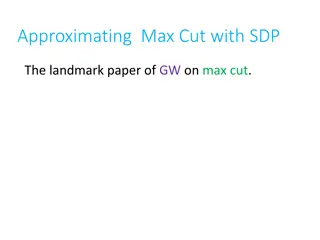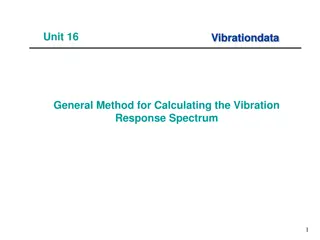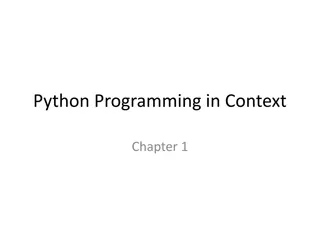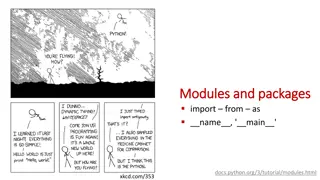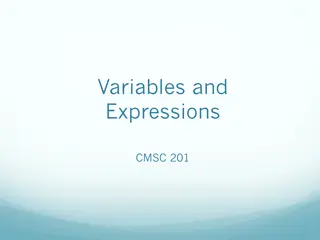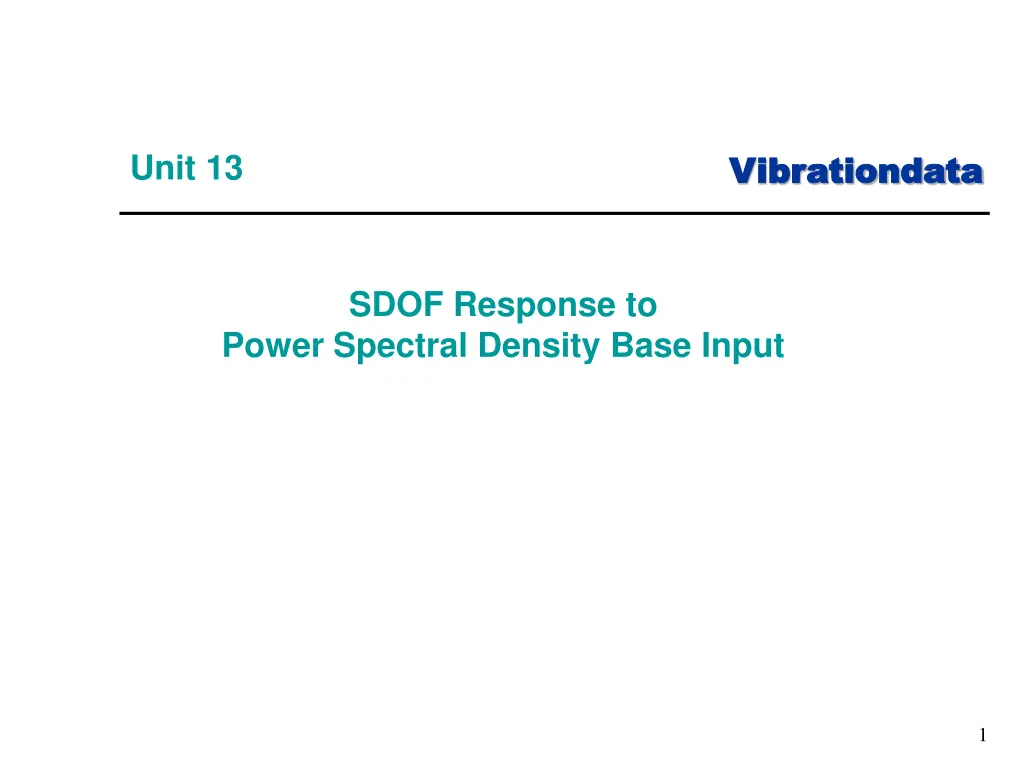
Vibrationdata: SDOF Response to White Noise Analysis
Explore the analysis of Single Degree of Freedom (SDOF) system response to white noise input through power spectral density processing. Generate white noise time history, determine PSD, analyze system response, and evaluate the resulting PSD.
Download Presentation

Please find below an Image/Link to download the presentation.
The content on the website is provided AS IS for your information and personal use only. It may not be sold, licensed, or shared on other websites without obtaining consent from the author. If you encounter any issues during the download, it is possible that the publisher has removed the file from their server.
You are allowed to download the files provided on this website for personal or commercial use, subject to the condition that they are used lawfully. All files are the property of their respective owners.
The content on the website is provided AS IS for your information and personal use only. It may not be sold, licensed, or shared on other websites without obtaining consent from the author.
E N D
Presentation Transcript
Vibrationdata Vibrationdata Unit 13 SDOF Response to Power Spectral Density Base Input 1
Exercise Vibrationdata Vibrationdata Generate a white noise time history: Duration = 60 sec Std Dev = 1 Sample Rate=10000 Hz Lowpass Filter at 2500 Hz Save Signal as: white_60_input_th.txt 2
Vibrationdata Vibrationdata Base Input Time History: white_60_input_th.txt 3
Exercise 5 (cont) Vibrationdata Vibrationdata Generate the PSD of the 60-second white noise time history Input: white_60_input_th Use case 9 which has f 5 Hz Mean Removal Yes & Hanning Window Plot from 10 to 2000 Hz Save PSD as: white_60_input_psd.txt 4
Vibrationdata Vibrationdata Base Input PSD: white_60_input_th The plateau is 0.0004 G2/Hz. 5
Vibrationdata Vibrationdata Recall SDOF Subjected to Base Input 6
Vibrationdata Vibrationdata SDOF Response to White Noise Subjected a SDOF System (fn=400 Hz, Q=10) to the 60-second white noise time history. Input: white_60_input_th.txt Use Vibrationdata GUI option: SDOF Response to Base Input Save Acceleration Response time history to: white_60_response_th.txt 7
Vibrationdata Vibrationdata Save Response Time History: white_60_response_th.txt 8
Vibrationdata Vibrationdata SDOF Response to White Noise PSD Take a PSD of the Response Time History Input: white_60_response_th.txt Mean Removal Yes & Hanning Window Use case 8 which has f 5 Hz Plot from 10 to 2000 Hz Save Response PSD: white_60_response_psd.txt 9
Vibrationdata Vibrationdata Response PSD: white_60_response_psd 10
Vibrationdata Vibrationdata Plot Both PSDs Go to: Miscellaneous Functions > Plot Utilities Select Input > Two Curves Curve 1: white_60_input_psd.txt Color: Red Legend: Input Curve 2: white_60_response_psd.txt Color: Blue Legend: Response Format: log-log X-axis: 10 to 2000 Hz X-label: Frequency (Hz) Y-label: Accel (G^2/Hz) 11
Vibrationdata Vibrationdata The SDOF system response has unity gain at low frequencies, below, say 50 Hz. Dynamic amplification occurs at the 400 Hz natural frequency. Attenuation occurs at frequencies beginning near 600 Hz. 12
Vibrationdata Vibrationdata Save as: trans.txt Calculate Power Transmissibility from the response and input PSDs using the Vibrationdata GUI package. The peak has a magnitude of Q2 =100, but this relationship usually only works for SDOF response. The 3 dB bandwidth method is more reliable for estimating the Q value. 13
Half-power Bandwidth Points (-3 dB) Vibrationdata Vibrationdata f = (420-378) Hz = 42 Hz x: 378 y: 49 Viscous Damping Ratio = f / (2 f ) = 42/ (2*400) 0.05 x: 420 y: 49 Q = 1 / ( 2 * 0.05 ) Q = 10 Response PSD: white_60_response_psd.txt 14
Curve-fit method using the Power Transmissibility Vibrationdata Vibrationdata Function Input array name: trans.txt Results fn = 400 Hz damping ratio = 0.0504 Q = 9.92 Miscellaneous Functions > Half Power Bandwidth Damping Curve-fit This curve-fitting method is actually an extension of the half power bandwidth method. 15
Vibrationdata Vibrationdata Miles Equation The Miles equation is a simplified method of calculating the response of a single-degree-of-freedom system to a random vibration base input, where the input is in the form of a power spectral density. Furthermore, the Miles equation is an approximate formula which assumes a flat power spectral density from zero to infinity Hz. As a rule-of-thumb, it may be used if the power spectral density is flat over at least two octaves centered at the natural frequency. Will cover in future Webinar. 16
Vibrationdata Vibrationdata Miles Equation The Miles equation is a simplified method of calculating the response of a single-degree-of-freedom system to a random vibration base input, where the input is in the form of a power spectral density. Furthermore, the Miles equation is an approximate formula which assumes a flat power spectral density from zero to infinity Hz. As a rule-of-thumb, it may be used if the power spectral density is flat over at least two octaves centered at the natural frequency. 17
Vibrationdata Vibrationdata Miles Equation (cont) The overall response acceleration is = XGRMS P fn Q 2 where fn = natural frequency P = PSD level at fn Q = amplification factor 18
Vibrationdata Vibrationdata Miles Equation Example SDOF System (fn = 400 Hz, Q=10) 2 G 10 X = 0.0004 400 Hz GRMS 2 Hz = 1.59 GRMS 19
Vibrationdata Vibrationdata Miles Equation, Relative Displacement The 3 relative displacement is 1 = Z 29 4 . Q P inch 3 5 . 1 n 2 f where fn = natural frequency P = PSD G^2/Hz level at fn Q = amplification factor 20
Vibrationdata Vibrationdata Better Method We will learn a method that is better than Miles equation in an upcoming Webinar! 21







